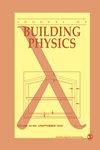空腔通风屋面结构热浮力模型
IF 1.4
4区 工程技术
Q3 CONSTRUCTION & BUILDING TECHNOLOGY
引用次数: 5
摘要
木制屋顶建筑通常通过屋顶护套下的空气腔通风,以从建筑中除去热量和水分。这种通风的驱动力是风压和热浮力。风驱动通风已经得到了广泛的研究,而浮力流动的预测模型还不发达。在本研究中,提出了一种新的分析模型来预测通风屋顶结构中由热浮力引起的气流。该模型为顶板施工提供了计算空腔瑞利数的方法,并将空腔瑞利数与风量进行了关联。将模型预测结果与实验和数值研究结果进行了比较,研究了不同空腔设计和倾角对通风屋顶中不同热负荷下空气流速的影响。在80多个不同的测试设置中,分析模型被发现在可接受的范围内复制实验和数值结果。增加屋顶总高度、空腔高度和给定建筑的太阳能热负荷的影响是增加通过空腔的空气流速。平均而言,对于类似的测试设置,分析模型预测的空气流速比数值研究中发现的高3%,比实验研究中发现的低20%。所提供的模型可用于预测不同设计的空腔内的空气流速,并量化建议的屋顶设计变化的影响。研究结果可作为屋面结构防潮安全性评估的依据。本文章由计算机程序翻译,如有差异,请以英文原文为准。
Model of thermal buoyancy in cavity-ventilated roof constructions
Timber roof constructions are commonly ventilated through an air cavity beneath the roof sheathing in order to remove heat and moisture from the construction. The driving forces for this ventilation are wind pressure and thermal buoyancy. The wind driven ventilation has been studied extensively, while models for predicting buoyant flow are less developed. In the present study, a novel analytical model is presented to predict the air flow caused by thermal buoyancy in a ventilated roof construction. The model provides means to calculate the cavity Rayleigh number for the roof construction, which is then correlated with the air flow rate. The model predictions are compared to the results of an experimental and a numerical study examining the effect of different cavity designs and inclinations on the air flow rate in a ventilated roof subjected to varying heat loads. Over 80 different test set-ups, the analytical model was found to replicate both experimental and numerical results within an acceptable margin. The effect of an increased total roof height, air cavity height and solar heat load for a given construction is an increased air flow rate through the air cavity. On average, the analytical model predicts a 3% higher air flow rate than found in the numerical study, and a 20% lower air flow rate than found in the experimental study, for comparable test set-ups. The model provided can be used to predict the air flow rate in cavities of varying design, and to quantify the impact of suggested roof design changes. The result can be used as a basis for estimating the moisture safety of a roof construction.
求助全文
通过发布文献求助,成功后即可免费获取论文全文。
去求助
来源期刊

Journal of Building Physics
工程技术-结构与建筑技术
CiteScore
5.10
自引率
15.00%
发文量
10
审稿时长
5.3 months
期刊介绍:
Journal of Building Physics (J. Bldg. Phys) is an international, peer-reviewed journal that publishes a high quality research and state of the art “integrated” papers to promote scientifically thorough advancement of all the areas of non-structural performance of a building and particularly in heat, air, moisture transfer.
 求助内容:
求助内容: 应助结果提醒方式:
应助结果提醒方式:


